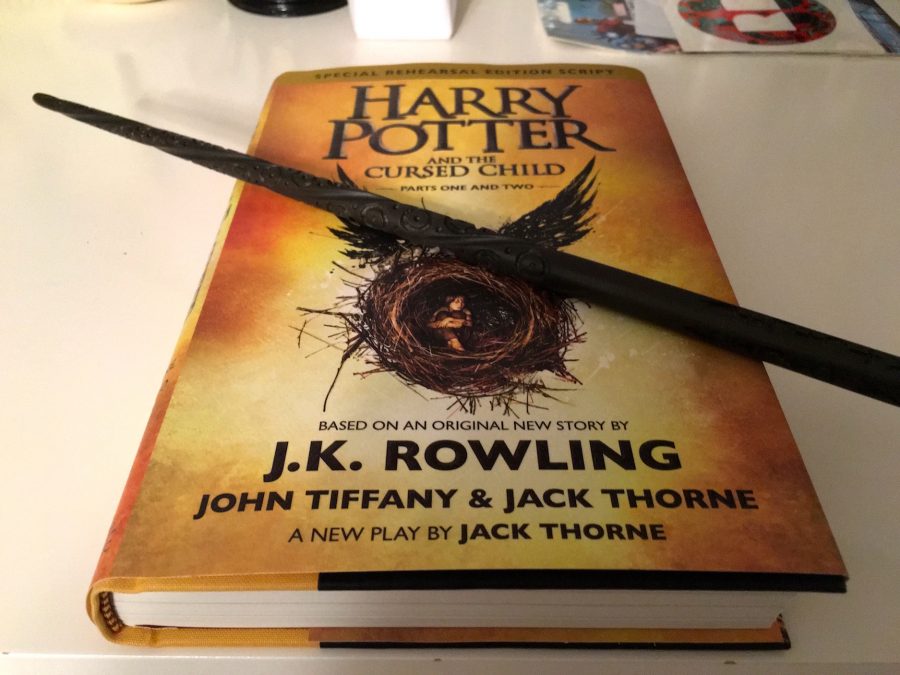Harry Potter and the Cursed Child helps fans return to Hogwarts
A student shows off the play Harry Potter and the Cursed Child, as well as a replica wand from the movie. The new piece, based on an original story by J.K. Rowling and written by Jack Thorne and John Tiffany, hit bookstores on July 31, 2016.
August 1, 2016
The eighth segment in the renowned Harry Potter series hit bookstores on July 31 in the form of the play, Harry Potter and the Cursed Child, based on an original story by J.K. Rowling and written by Jack Thorne and John Tiffany.
The play, which began performances on London’s West End starting on July 30, picks up after the epilogue of last book, Harry Potter and the Deathly Hallows, and follows the famous wizard and his son, Albus, through a time-traveling fight against dark magic. It also features a much older Ron Weasley, Hermione Granger, Ginny Weasley, Draco Malfoy and his son Scorpius, and a swath of other characters from the series.
The story itself reads quickly due to its medium as well as a plot that moves at lightning speeds through four full acts. The ever-changing setting of the show, from Godric’s Hollow in 1981 to Hogwarts in 2020, helps keep readers engaged and adds an extra level of complexity. Through the traveling as well, the authors call upon the reader to stretch his or her imagination to the limit in the universe so well-known to fans.
Furthermore, the play’s characters reflect not only their originals in the novels but also important character developments with changing times. For example, the relationship between the titular wizard and his son Albus Potter takes precedence in the story and allows each character to explore depths previously left out of the novels, including the qualities of a successful father and living up to reputations.
Particularly shining moments of character development and relationships include the banter between unlikely friends Scorpius Malfoy and Albus Potter, reflections on Harry’s guilt over Cedric Diggory and his parents’ death, frightening looks into a wizarding world ruled by Voldemort, and Neville Longbottom’s surprising importance.
While the show only just began its run on the West End, the stage directions included in Harry Potter and the Cursed Child reflect the potential of beauty for the show. With stage directions calling for multiple time traveling sequences as well as transition sequences meant to look enchanted, the stage production (and the images it evokes in readers) reflects all the magic of the original books and movies. Plus, the production notes mention a magician and illusionist on board, adding to the beautiful scenes played out in readers’ mind.
Arguably the most important part of the play lies in more-than-human characters reflecting the best of human judgement, guilt, and love. Cursed Child highlights the problems with judging people based on labels (clearly laid out in Hogwarts house) or the reputations of their parents, as well as loving children for their qualities. The story and morals appeal to children but apply even more to adults, especially current parents who read the first seven books as adolescents. Most impressively, Rowling, Thorne, and Tiffany admit to certain flaws in their own characters, from the wise Albus Dumbledore to Harry himself. By showcasing the flaws instead of ignoring them, the authors reveal their dedication to the characters and their development, as well as the large fanbase.
Continuing the wizard’s journey, Harry Potter and the Cursed Child evokes the same magical nostalgia of the original books while adapting a new story for the stage. With a cast of characters spanning back to the beginning of the novels, an interesting choice of stage directions and character dynamics, and a frightening challenge by the master of the dark arts, the play will satisfy Harry Potter lovers and falls in line as a staple of the theater world.
The Chant’s Grade: A







